CAMIGUIN (MindaNews / 19 May) — On the island of Camiguin in Mindanao, a volcano is coming back to life.
Though she hasn’t erupted in 70 years, Mt. Hibok-Hibok has been especially quiet lately. From March 2020 to November 2021, the Timpoong Hibok-Hibok Natural Monument hosted exactly zero visitors.
“Mt. Hibok-Hibok was once a popular hiking destination, especially after Pinoy Mountaineer featured it in 2007. Climbers came daily because our volcano offers elements of other famous Mindanao mountains: Mt. Apo’s crater lake, the roped ascents of Mt. Kitanglad, even Mt. Dulang-Dulang’s mossy forest. Visitors often dive straight to the sea after climbing, for Camiguin is surrounded by famed beaches like white island,” explains mountain guide Ronald Rabiles as we trek up a fern-filled trail.
 Mts. Timpoong (left), Hibok-Hibok (center) and Vulcan (right) as seen from Camiguin’s famed white island. The Timpoong Hibok-Hibok Natural Monument is just one of the country’s 246 protected areas, most now open for tourists seeking adventure. (Gregg Yan / UNDP BIOFIN)
Mts. Timpoong (left), Hibok-Hibok (center) and Vulcan (right) as seen from Camiguin’s famed white island. The Timpoong Hibok-Hibok Natural Monument is just one of the country’s 246 protected areas, most now open for tourists seeking adventure. (Gregg Yan / UNDP BIOFIN)
Ecotourism is a vital lifeline of Philippine protected areas. Zero visitor means no employment for guides and porters, plus less funds for park upkeep. Here in Mt. Hibok-Hibok, guides earn around PhP1,500 (USD 30) daily, while porters make PhP 800 (USD 16) for hauling 20 or so kilos of supplies.
“I come from three generations of mountain guides. This is a way of life for my father, myself and my son,” adds Ronald. “The two-year COVID lockdown hit us hard. Losing our main means of income was like sweeping the rug from under us. I had to look for other ways to support my five kids. Good thing I found temporary employment as a welder and day laborer. I’m one of the lucky ones: other guides tilled land just to feed their families.”
Visitors Trickling In
After two years, the country’s national parks are finally seeing an influx of visitors. Apo Reef in Occidental Mindoro hosted just 35 tourists from March 2020 to March 2022. Since reopening in April 2022, 212 people have visited the park, generating nearly PhP 250,000 from fees. Mt. Pulag, the highest peak in Luzon, saw visitor numbers drop from over 43,000 in 2019 to just over a thousand in 2021. Numbers are rebounding with over 2,700 visitors since January 2022, generating nearly PhP 500,000 in revenues.
With easing travel restrictions, officials from the Department of Environment and Natural Resources (DENR) hope to see more people visiting Mt. Hibok-Hibok and other Philippine national parks.
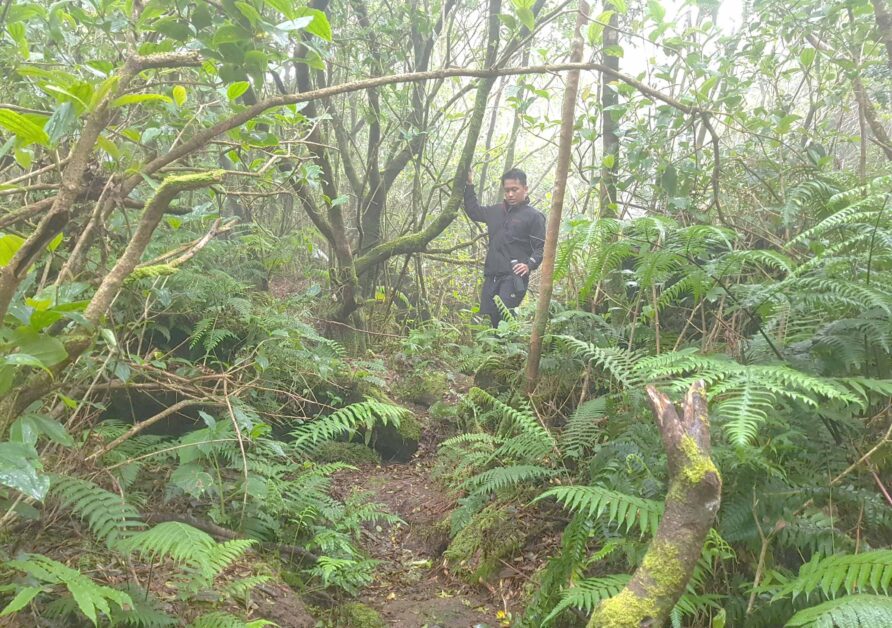 A DENR ranger explores the misty ridges of Mt. Hibok-Hibok in Camiguin. The volcano features well-marked trails traversing a wide variety of habitats. (Gregg Yan / UNDP BIOFIN)
A DENR ranger explores the misty ridges of Mt. Hibok-Hibok in Camiguin. The volcano features well-marked trails traversing a wide variety of habitats. (Gregg Yan / UNDP BIOFIN)
“We started accepting clients in December 2021. Since then, over 130 people have visited the mountain, generating about PhP 31,000 in park fees and employing dozens of guides and porters. Clients are the lifeblood of the mountain,” says Camiguin-based DENR forester Lito Babaison.
We’re this month’s latest batch of visitors. Our mixed team from the United Nations Development Programme (UNDP), Department of Tourism (DOT) and DENR employed over 20 guides, rangers and porters. We’re here to shoot a video for YoPA or the Year of the Protected Areas, slated to launch this 23rd of May.
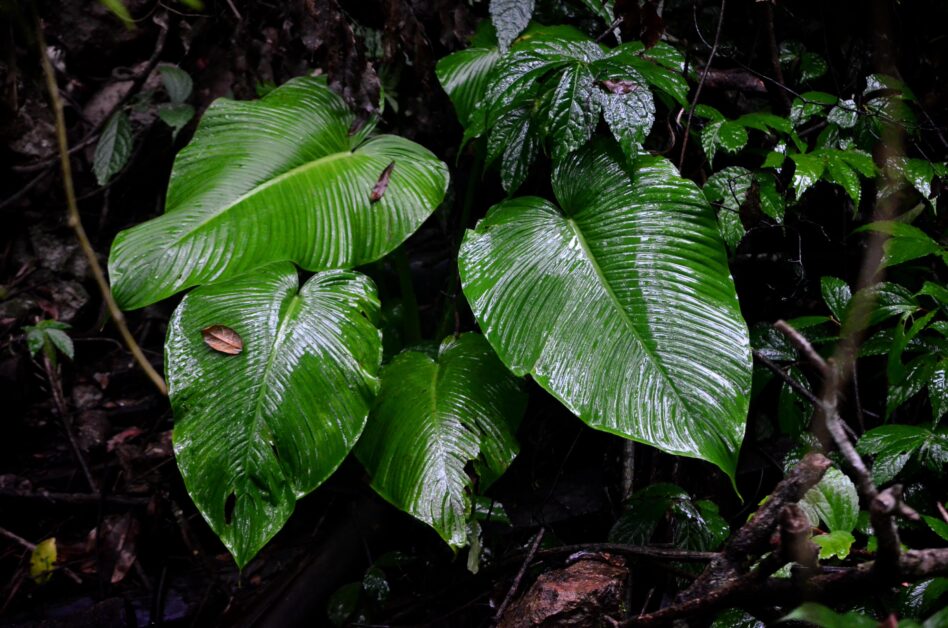 Dripping wet. Mt. Hibok-Hibok currently welcomes visitors to experience firsthand just what a mossy forest is like. “A good way to sustain our protected areas is to ensure they’re regularly visited by tourists,” says DENR Biodiversity Management Bureau (DENR-BMB) director Natividad Bernardino. (Gregg Yan / UNDP BIOFIN)
Dripping wet. Mt. Hibok-Hibok currently welcomes visitors to experience firsthand just what a mossy forest is like. “A good way to sustain our protected areas is to ensure they’re regularly visited by tourists,” says DENR Biodiversity Management Bureau (DENR-BMB) director Natividad Bernardino. (Gregg Yan / UNDP BIOFIN)
A collaboration between the DENR, DOT and DILG, YoPA aims to bring visitors back to the country’s national parks – renowned biodiversity bastions like Mt. Hamiguitan in Davao Oriental, Bongsanglay Natural Park in Masbate and the Balinsasayao Twin Lakes in Negros Oriental.
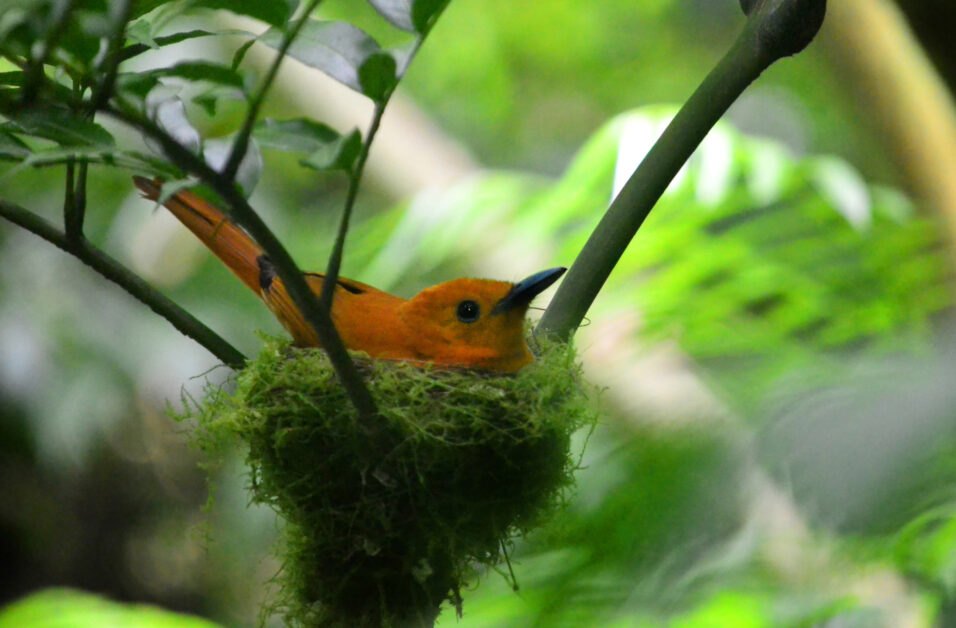 We encountered this rufous paradise flycatcher (Terpsiphone cinnamomea) nesting quietly in the forest. “Camiguin is a birdwatcher’s paradise, with at least 57 bird species,” explains wildlife guide Gloria Abian. (Gregg Yan / UNDP BIOFIN)
We encountered this rufous paradise flycatcher (Terpsiphone cinnamomea) nesting quietly in the forest. “Camiguin is a birdwatcher’s paradise, with at least 57 bird species,” explains wildlife guide Gloria Abian. (Gregg Yan / UNDP BIOFIN)
“The Philippines hosts 246 protected areas and all of them need funding. With the challenges brought about by the COVID pandemic, government resources are thinly stretched, so part of upkeep funds must come from the public via ecotourism. A good way to sustain our protected areas is to ensure they’re regularly visited by tourists,” says UNDP BIOFIN Manager Anabelle Plantilla.
Climbing the Volcano
It’s tough going up Yumbing Trail, one of two paths up Mt. Hibok-Hibok. I’d just climbed a mountain in Africa and this trail is no walk in the park, bristling with thorny rattan palms which love to latch onto clothing. Mountaineers call these teka-teka vines for “teka-teka” or “Wait a minute while I extricate myself from these damned vines!”
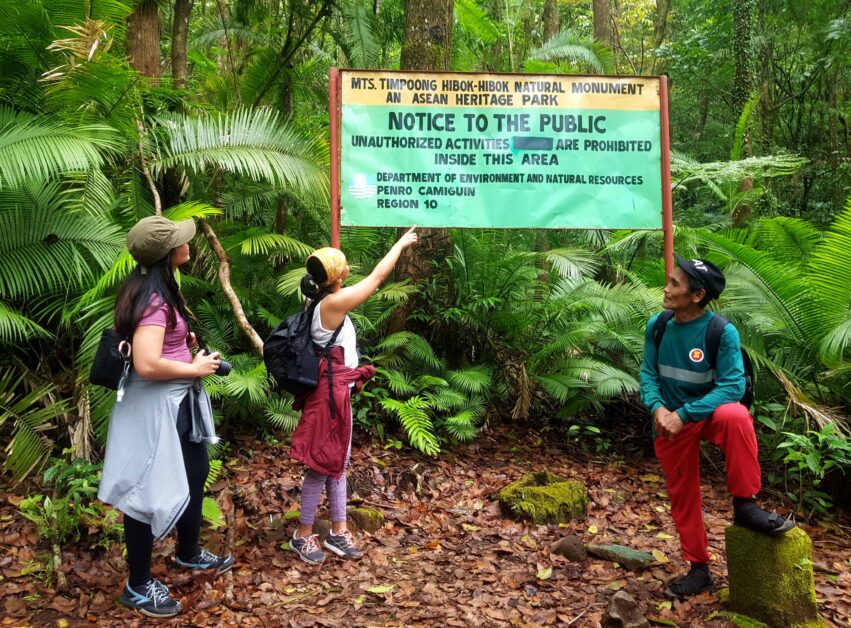 Trekkers take a quick breather at one of Mt. Hibok-Hibok’s well-marked rest stops. Since reopening to the public in December 2021, the park has hosted over 130 climbers, with more scheduled to visit in the coming months. (Gregg Yan / UNDP BIOFIN)
Trekkers take a quick breather at one of Mt. Hibok-Hibok’s well-marked rest stops. Since reopening to the public in December 2021, the park has hosted over 130 climbers, with more scheduled to visit in the coming months. (Gregg Yan / UNDP BIOFIN)
The two-day trek starts among a swaying sea of coconut palms. Soon the trail transforms into a Jurassic Park set, walls of green obscured by wet, rolling mist. Near the top, the trail opens up into a grassy crater several football fields wide. There’s a small lake where swiftlets and other birds play.
“Don’t talk or laugh too loudly,” cautions Ronald. “The old ones swear this mountain hosts an enchanted spirit guardian who lives in the lake.” I silently cancel my original plan of going swimming. That night Ronald swore he saw the spirit walking through our campsite, protecting us.
As we descend the next day, Ronald turns to me. “Climbers keep mountains alive, but some aren’t so disciplined. We guides aren’t just here to take you to the peak and back, but to ensure no one leaves garbage or lights a fire which can burn down the park. We also have plantitas who love to pluck orchids and other plants illegally. Like the guardian in the lake, we protect this mountain too. A beautiful mountain will attract visitors, which means we’ll always have jobs.”
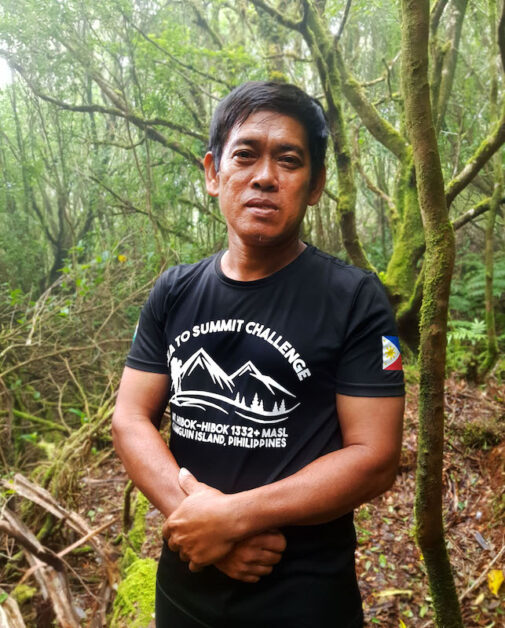 Park protector. “We guides aren’t just here to take you to the peak and back, but to ensure no one leaves garbage or lights a fire which can burn down the park. A beautiful mountain will attract visitors, which means we’ll always have jobs,” says guide Ronald Rabiles. (Gregg Yan / UNDP BIOFIN)
Park protector. “We guides aren’t just here to take you to the peak and back, but to ensure no one leaves garbage or lights a fire which can burn down the park. A beautiful mountain will attract visitors, which means we’ll always have jobs,” says guide Ronald Rabiles. (Gregg Yan / UNDP BIOFIN)
Mt. Hibok-Hibok hasn’t erupted since 1953, but the fire of Ronald and its other protectors are definitely keeping this volcano stoked and alive. (Gregg Yan / UNDP BIOFIN)
(BIOFINwas launched in 2012 and seeks to address the biodiversity finance challenge in a comprehensive manner – building a sound business case for increased investments in the management of ecosystems and biodiversity, with a particular focus on the needs and transformational opportunities at the national level. For more information: http://www.biodiversityfinance.net
